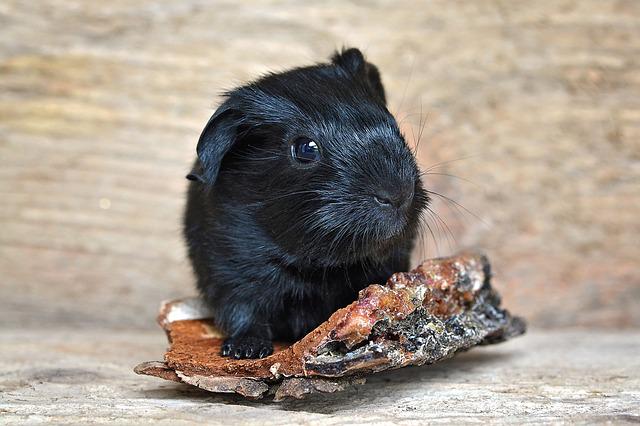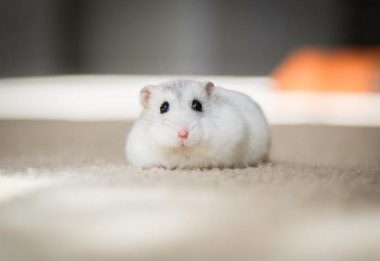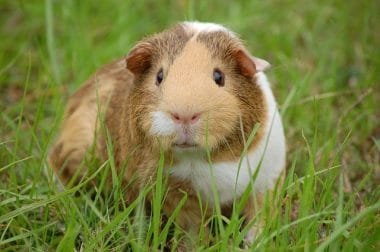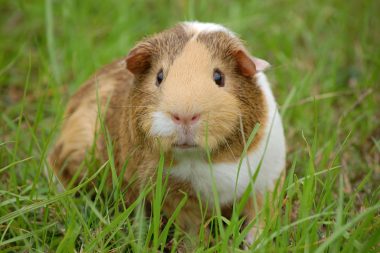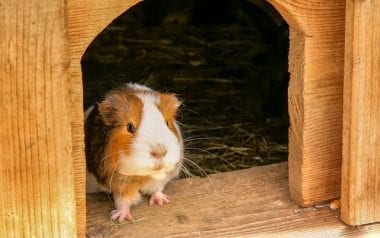The first step in properly picking up and managing your pet is to understand why it runs when you try to pick them up. Because guinea pigs live in the wild, they are preyed upon by a variety of attackers, including reptiles, cats, raptors, eagles, and even people.
When they feel threatened, they are hardwired to flee and conceal. That is why they head straight for something when you start picking them up.
With time and as you develop a relationship with your pet, they may be less likely to flee. But you ought not to take it personally. It is a natural part of who they are and what they do.
Should you pick your guinea pigs up?
It is not only acceptable but also necessary, to pick up your pet piggy. It is because guinea pigs are gregarious animals who enjoy being around other pigs and humans.
Picking up and handling your guinea pig appropriately offers various advantages for both you and your lovely little guinea pig. It includes the following:
- Creating that crucial relationship with your pet.
- Hygiene treatments, as well as visits to the veterinarian, will be a way simpler.
- Keeping your guinea pig from being lonely and melancholy, and thereby avoiding major ailments.
- Giving the pig the mental and physical enrichment it needs to be fit.
Before you know how to pick up a guinea pig and snuggle, you should learn to pick it up and control it. It will keep your piggy calm in the future and prevent injuries for both of you.
Why should you learn the correct way of picking up a guinea pig?
Guinea pigs’ limbs are fragile, and a drop, especially from a reasonable height, can result in catastrophic injuries such as fractured bones, inner injury, and bruises. Mishaps can also make your pet feel insecure and apprehensive about being treated.
Guinea pigs may wiggle and bounce. Therefore, no matter how prepared you are, you must constantly support your guinea pig. Excessive noise or unexpected actions might frighten your pet. If this happens when carrying them at an elevation, a fall might result in serious harm. Thus, learning how to pick up a guinea pig safely is critical.
What is the correct approach to pick up a guinea pig?
Imagine you are a new pig parent or have recently introduced a member to your animal clan. You will need to treat it differently than if you have had one before. Check out our list of safety tips for picking, managing, and transporting little pigs.
Dos
- Make sure you are on the floor:
When you consider it, most predators are much larger than guinea pigs. That is why it is preferable to confront them from their perspective. They will be less afraid and much more likely to approach you.
- Place your hand in the hutch slowly:
We recommend using gradual, delicate motions whether placing your hand in the hutch or running. It is because quick movements will drive your guinea pig to flee.
- Be careful where you place your hands:
Don’t get too close to your guinea pig with your hand. They are inherently interested and will seek you out to learn more about you. They won’t feel intimidated or uncomfortable around you as they become more accustomed to your scent.
- Be as communicating as possible:
Interacting with your guinea pigs will aid in the process of bonding as well. They will feel more comfortable and confident around you as they become accustomed to your voice and learn to recognize it.
- Have patience:
Learn to remain patient, notably if the situation necessitates it. It will take some time for your guinea pig to adjust to its new surroundings. Pushing the procedure will make your pet uncomfortable and uneasy near you.
Don’ts:
- Do not sneak in from their behind:
Approaching your pets from behind is not a good idea. It has the potential to frighten it to death. Allowing small kids to prod at your dwarf pigs through the cage or reaching in to grasp them is not a good idea.
- Do not plunge on your guinea pigs:
Recall how we stated that when picking up your guinea pig, it is better to get down on its level? Most of the predators may descend and seize it in the wild. If your pig senses that it is being pursued, it will flee and hide.
- Do not make noise near the guinea pigs:
Don’t be overly obnoxious. Tiny guinea pigs are afraid of loud noises. You must remember to always speak to them in a quiet and soft tone. Don’t rage and yell in their presence.
How to pick up a guinea pig?
Before we go into how to pick up your piggy, keep in mind that it should always be handled with care. They may be charming and cuddly, but guinea pigs are not entertainment. Harsh handling can result in serious damage, and in rare circumstances, fatality.
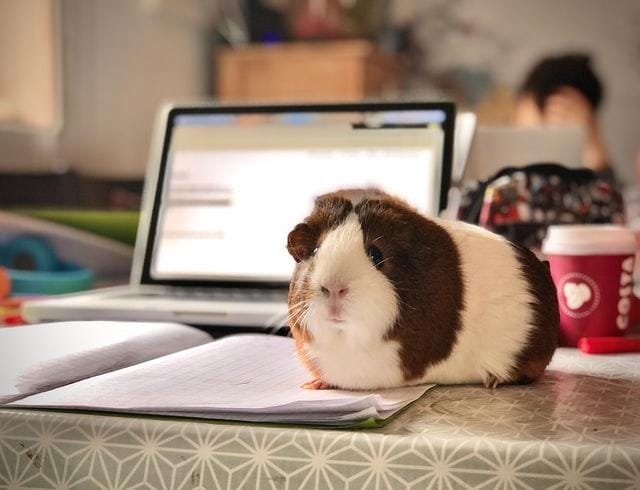
Picking up and carrying guinea pigs is rather simple once you’ve become used to it. Here’s how to pick up a guinea pig:
Step 1: Place one palm across the torso or below it if you wish.
Step 2: With your other hand, support their back legs.
Step 3: To avoid injuring your guinea pig’s vertebrae, keep its feet toward the ground.
Step 4: Keep your piggy near to the ground at all times. It is less likely to be gravely damaged if it wriggles or leaps out of your hands.
Step 5: You must hold guinea pigs close to your bosom when transporting them. They will feel safer this way, and you will be less likely to drop them.
How many times should you pick up your guinea pigs?
You must pick up your guinea pigs at least once a day for them to flourish and be happy. Snuggle time is an important element of keeping a guinea pig since it helps it settle. It also allows you to check for any potential health risks.
However, as much as your pig like one-on-one time with you, they do not enjoy being touched for lengthy periods. We recommend keeping your pet for no more than 20 to 30 minutes. After all, if your guinea pig is still becoming acclimated to you, you may only get around 10 to 15 minutes of snuggling until it decides it had sufficiently.
How to guess if the guinea pig does not want to be held?
It is a simple issue to address. Your guinea pig will let you know when it is had enough of being held. Striving, lapping your hands, and a little nip are all indicators that it has to go to the potty or be cast aside. If you disregard these warning signs, your piggy might bite a bit harder to catch your attention.
It becomes simpler to comprehend your piggy’s noises and behavior as you spend more time with it.
Should you pick up a pregnant guinea pig?
Although guinea pigs enjoy being stroked and hugged, you should only hand an expectant piggy if essential. It is particularly significant one month before the birth of their children.
Furthermore, don’t pick them up anytime quickly after they have been born. They may want to be with their children, but they will also be hurting and unpleasant.
How to put your guinea pig into its cage?
Some pig parents just lower their babies to the floor and afterward abandon them. While this may appear to be the ideal strategy, your guinea pigs must realize that playing is done. You are returning it to its cage, rather than believing it has fled.
Let us look at ways to reintroduce your guinea pigs to their cage or enclosure.
Step 1: Keep your guinea pig from wriggling or squirming from your grasp. As you drop it to the ground, be sure you hold it securely in your hands.
Step 2: If a pet pig tends to sprint, we recommend sliding it into the box from the ground first. It will reduce the likelihood of it racing away and avoid any injury.
Step 3: This stage is optional. However, it is beneficial if you have a hopper on your palms. Also, it would be helpful if you and your piggy still are trying to get to know each other. Guinea pigs are particularly vulnerable to injury if they try to leap from your grasp.
When should you start picking up newly born guinea pigs?
We recommend not handling a newborn guinea pig for at least a week once it has been born, as enticing as it may seem.
The most important thing to remember while picking up and handling young guinea pigs is patience and compassion. Your pet needs you to be calm, consistent, and patient as it adjusts to you and its new surroundings.
What are some tips to consider while handling guinea pigs?
Following are some tips on how to pick up a guinea pig:
- Before (and after) touching a guinea pig, always wash your hands. It would guarantee that you do not contain any germs or pathogens that might hurt your pet. It will also eliminate any food odor.
- You must avoid smelling artificial because this will hinder your guinea pig from acquiring your distinct aroma. As a result, refrain from picking up your pet just after it has been sprayed.
- Consider the environment in which you will be handling your guinea pig. Make sure there are no dogs or cats in the room with you in case they mistake your little creature for a toy or delectable snack. Even if you believe your other pets will get along with your guinea pigs, it is best to keep them separated.
- Please ensure the space is devoid of obstructions, so you don’t trip while carrying your guinea pig. You must have always had obvious access to immediately shift your pet to a safe location.
- Any potential exit doors should be avoided at all costs. If you lose your pet by mistake, you must be assured that they will not be able to escape. They can move exceedingly swiftly.
- The surrounding should be devoid of any potentially frightening, unanticipated loud noises, since this may terrify your guinea pig and drive it to flee. It is especially crucial when they are little, and you are sharing your initial managing encounters. For them, a barking dog or a television show with loud bursts might be quite frightening.
- It is a great idea to dress in clothes you don’t bother taking dirty. They are rarely to defecate on you if you hold them for an extended period (15 minutes is the limit). You will, however, acquire a lot of hair (even from short-haired piggies) and the occasional feces.
- Using food as a ‘lure’ and a treat, very squirmy or frightened animals may benefit from being enticed into handling. To make this procedure as enjoyable as possible, do have special fresh veggie snacks available (a piece of cucumber or lettuce is ideal).
